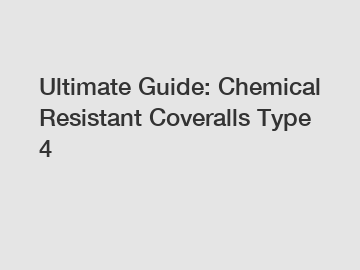Ultimate Guide: Chemical Resistant Coveralls Type 4
Ultimate Guide: Chemical Resistant Coveralls Type 4.
When it comes to personal protective equipment (PPE), chemical resistant coveralls are crucial in ensuring the safety of workers who come into contact with hazardous substances. Among the various types of chemical resistant coveralls, Type 4 coveralls stand out for their excellent protective properties and versatility. In this ultimate guide, we will delve into everything you need to know about Chemical Resistant Coveralls Type 4.
What are Chemical Resistant Coveralls Type 4?

Chemical resistant coveralls Type 4 are specially designed to protect workers from liquid chemicals and sprays. These coveralls provide a high level of protection against a wide range of hazardous substances, including gases, particles, and liquids. They are typically used in industries such as pharmaceuticals, petrochemicals, agriculture, and industrial manufacturing, where workers are exposed to various chemical hazards.
1. Material and Construction.
Chemical resistant coveralls Type 4 are made from specialized materials that offer excellent resistance to chemicals. These materials include heavyweight non-woven fabrics such as polypropylene or polyethylene. They are also equipped with features like taped seams and sealed zippers to prevent any potential entry points for chemicals. Additionally, Type 4 coveralls often have elastic cuffs, ankles, and hoods to provide a secure and comfortable fit.
2. Protection Level.
Chemical resistant coveralls Type 4 are classified according to their protection level against liquid chemicals. They are tested and certified under the European standard EN 14605. Type 4 coveralls provide the highest level of protection against liquid spray and aerosols. They are resistant to a broad range of chemicals, including acids, alkalis, solvents, and oils. This makes them an ideal choice for workers who handle corrosive substances or are exposed to potentially dangerous liquids.
3. Features and Benefits.
Type 4 coveralls offer several features that enhance their usability and effectiveness. They typically have a two-way front zipper, which allows for easy donning and doffing, along with a storm flap for added protection against liquid entry. Some coveralls also feature a breathable back panel to ensure comfort during extended wear. Moreover, most Type 4 coveralls are designed with an ergonomic hood that enables a wide field of vision and compatibility with other PPE, such as safety goggles or respirators.
4. Proper Use and Maintenance.
To ensure the maximum effectiveness of Chemical Resistant Coveralls Type 4, it is essential to follow proper usage and maintenance protocols. Workers must be trained on the correct way to wear and remove the coveralls, paying attention to the seals and closures to prevent any chemical exposure. It is also important to inspect coveralls regularly for any signs of damage and to replace them when necessary. Proper laundering or disposal of coveralls should be carried out according to manufacturer instructions or industry regulations.
Conclusion.
Chemical Resistant Coveralls Type 4 serve as a vital protective barrier against hazardous chemicals in various industries. With their exceptional resistance to liquid sprays and aerosols, they provide workers with a high level of protection. By understanding the material and construction, protection level, features, and proper use and maintenance, you can ensure optimal safety for workers exposed to chemical hazards.
For further information or assistance in selecting the right Chemical Resistant Coveralls Type 4 for your needs, please do not hesitate to contact us. Stay safe and protected!
Keywords: contact us.
Contact us to discuss your requirements of surgical drapes types, isolation safety clothing, Choose The Correct Chemical Coverall. Our experienced sales team can help you identify the options that best suit your needs.
242
0
0

Comments
All Comments (0)